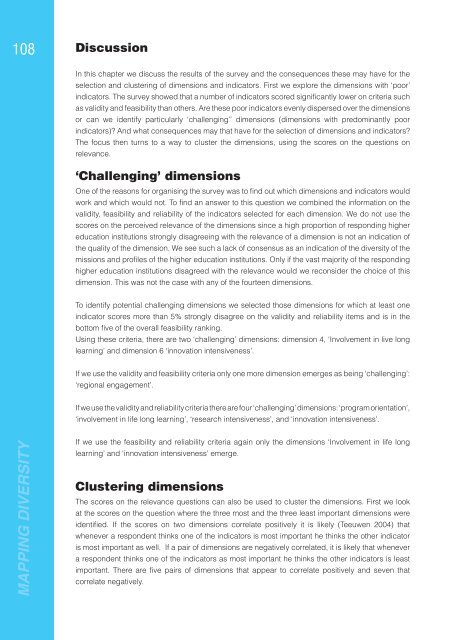Mapping Diversity: Developing a European Classification of ... - U-Map
Mapping Diversity: Developing a European Classification of ... - U-Map
Mapping Diversity: Developing a European Classification of ... - U-Map
You also want an ePaper? Increase the reach of your titles
YUMPU automatically turns print PDFs into web optimized ePapers that Google loves.
108 Discussion<br />
In this chapter we discuss the results <strong>of</strong> the survey and the consequences these may have for the<br />
selection and clustering <strong>of</strong> dimensions and indicators. First we explore the dimensions with ‘poor’<br />
indicators. The survey showed that a number <strong>of</strong> indicators scored signifi cantly lower on criteria such<br />
as validity and feasibility than others. Are these poor indicators evenly dispersed over the dimensions<br />
or can we identify particularly ‘challenging’’ dimensions (dimensions with predominantly poor<br />
indicators)? And what consequences may that have for the selection <strong>of</strong> dimensions and indicators?<br />
The focus then turns to a way to cluster the dimensions, using the scores on the questions on<br />
relevance.<br />
‘Challenging’ dimensions<br />
One <strong>of</strong> the reasons for organising the survey was to fi nd out which dimensions and indicators would<br />
work and which would not. To fi nd an answer to this question we combined the information on the<br />
validity, feasibility and reliability <strong>of</strong> the indicators selected for each dimension. We do not use the<br />
scores on the perceived relevance <strong>of</strong> the dimensions since a high proportion <strong>of</strong> responding higher<br />
education institutions strongly disagreeing with the relevance <strong>of</strong> a dimension is not an indication <strong>of</strong><br />
the quality <strong>of</strong> the dimension. We see such a lack <strong>of</strong> consensus as an indication <strong>of</strong> the diversity <strong>of</strong> the<br />
missions and pr<strong>of</strong>i les <strong>of</strong> the higher education institutions. Only if the vast majority <strong>of</strong> the responding<br />
higher education institutions disagreed with the relevance would we reconsider the choice <strong>of</strong> this<br />
dimension. This was not the case with any <strong>of</strong> the fourteen dimensions.<br />
To identify potential challenging dimensions we selected those dimensions for which at least one<br />
indicator scores more than 5% strongly disagree on the validity and reliability items and is in the<br />
bottom fi ve <strong>of</strong> the overall feasibility ranking.<br />
Using these criteria, there are two ‘challenging’ dimensions: dimension 4, ‘Involvement in live long<br />
learning’ and dimension 6 ‘innovation intensiveness’.<br />
If we use the validity and feasibility criteria only one more dimension emerges as being ‘challenging’:<br />
‘regional engagement’.<br />
If we use the validity and reliability criteria there are four ‘challenging’ dimensions: ‘program orientation’,<br />
‘involvement in life long learning’, ‘research intensiveness’, and ‘innovation intensiveness’.<br />
MAPPING DIVERSITY<br />
If we use the feasibility and reliability criteria again only the dimensions ‘Involvement in life long<br />
learning’ and ‘innovation intensiveness’ emerge.<br />
Clustering dimensions<br />
The scores on the relevance questions can also be used to cluster the dimensions. First we look<br />
at the scores on the question where the three most and the three least important dimensions were<br />
identifi ed. If the scores on two dimensions correlate positively it is likely (Teeuwen 2004) that<br />
whenever a respondent thinks one <strong>of</strong> the indicators is most important he thinks the other indicator<br />
is most important as well. If a pair <strong>of</strong> dimensions are negatively correlated, it is likely that whenever<br />
a respondent thinks one <strong>of</strong> the indicators as most important he thinks the other indicators is least<br />
important. There are fi ve pairs <strong>of</strong> dimensions that appear to correlate positively and seven that<br />
correlate negatively.

















